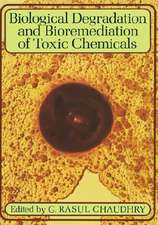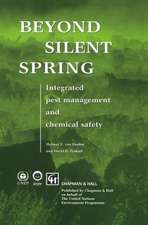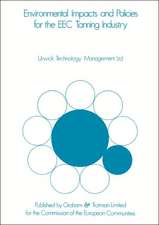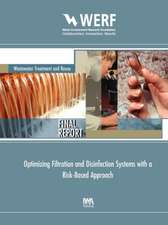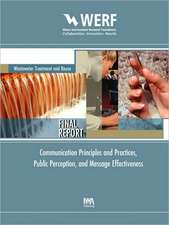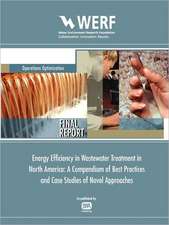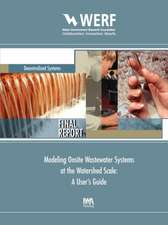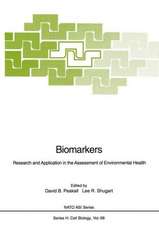Animal Biomarkers as Pollution Indicators: Chapman & Hall Ecotoxicology Series
Editat de David B. Peakallen Limba Engleză Paperback – 5 noi 2012
| Toate formatele și edițiile | Preț | Express |
|---|---|---|
| Paperback (1) | 1217.90 lei 6-8 săpt. | |
| SPRINGER NETHERLANDS – 5 noi 2012 | 1217.90 lei 6-8 săpt. | |
| Hardback (1) | 1224.06 lei 6-8 săpt. | |
| SPRINGER NETHERLANDS – 31 dec 1991 | 1224.06 lei 6-8 săpt. |
Preț: 1217.90 lei
Preț vechi: 1485.24 lei
-18% Nou
Puncte Express: 1827
Preț estimativ în valută:
233.04€ • 243.31$ • 192.87£
233.04€ • 243.31$ • 192.87£
Carte tipărită la comandă
Livrare economică 04-18 aprilie
Preluare comenzi: 021 569.72.76
Specificații
ISBN-13: 9789401050364
ISBN-10: 9401050368
Pagini: 320
Ilustrații: XXIII, 291 p.
Dimensiuni: 155 x 235 x 17 mm
Greutate: 0.45 kg
Ediția:Softcover reprint of the original 1st ed. 1992
Editura: SPRINGER NETHERLANDS
Colecția Springer
Seria Chapman & Hall Ecotoxicology Series
Locul publicării:Dordrecht, Netherlands
ISBN-10: 9401050368
Pagini: 320
Ilustrații: XXIII, 291 p.
Dimensiuni: 155 x 235 x 17 mm
Greutate: 0.45 kg
Ediția:Softcover reprint of the original 1st ed. 1992
Editura: SPRINGER NETHERLANDS
Colecția Springer
Seria Chapman & Hall Ecotoxicology Series
Locul publicării:Dordrecht, Netherlands
Public țintă
ResearchCuprins
1 Scope and limitations of classical hazard assessment.- 1.1 The exposure side of the equation.- 1.2 The toxicity side of the equation.- 1.3 Hazard assessment.- 2 Biomarkers of the nervous system.- 2.1 Esterase inhibition.- 2.2 Biogenic amines.- 3 Biomarkers of the reproductive system.- 3.1 Studies of the breeding cycle.- 3.2 Studies on embryos.- 3.3 Hormones.- 4 Studies on genetic material.- 4.1 Introduction.- 4.2 RNA/DNA ratio.- 4.3 DNA adducts.- 4.4 DNA strand breakage.- 4.5 Degree of methylation of DNA.- 4.6 Sister chromatid exchange.- 4.7 Use of genetic material in monitoring.- 5 Mixed function oxidases.- 5.1 Introduction.- 5.2 Nomenclature.- 5.3 General description of the system.- 5.4 Factors influencing activity.- 5.5 Interactions with other biomarkers.- 5.6 Mechanism of action, receptors and dioxin equivalents.- 5.7 Use of mixed function oxidases as biomarkers.- 6 Thyroid function, retinols, haem and regulatory enzymes.- 6.1 Thyroid function.- 6.2 Vitamin A (retinoids).- 6.3 Haem, porphyrins and inhibition of aminolevulinic acid dehydratase (ALAD) by lead.- 6.4 Enzyme activity.- 7 Behavioural effects: their relationship to physiological changes.- 7.1 Introduction.- 7.2 Types of tests used.- 7.3 Behavioural effects of polyhalogenated aromatic hydrocarbons.- 7.4 Behavioural effects of organophosphates.- 7.5 Behavioural effects of heavy metals and other pollutants.- 7.6 Relationship of behavioural effects to biomarkers.- 8 Environmental immunotoxicology.- 8.1 Introduction.- 8.2 The immune system as a target for xenobiotic interaction.- 8.3 Relationship of immunotoxicology and other toxic effects.- 8.4 Immunotoxic chemicals.- 8.5 Assessment and prediction of immunotoxicity.- 8.6 Application of immunoassays in environmental studies.- 8.7 Conclusions.- 9 The use of animals in wildlife toxicology.- 9.1 Introduction.- 9.2 The LD50 and related tests.- 9.3 Comparison of measurements in blood to organs.- 9.4 The role of tissue culture experiments.- 9.5 Statistical considerations.- 10 The role of biomarkers in environmental assessment.- 10.1 Biomarkers and the epidemiological approach.- 10.2 Current status of monitoring based on biomarkers.- 10.3 Relationship between chemical exposure and biomarker response.- 10.4 Relationship between responses of biomarkers to adverse effects.- 10.5 Strategy for using biomarkers.- Appendix 1 Latin names of species referred to in text.- Appendix 2 Abbreviations.- References.





